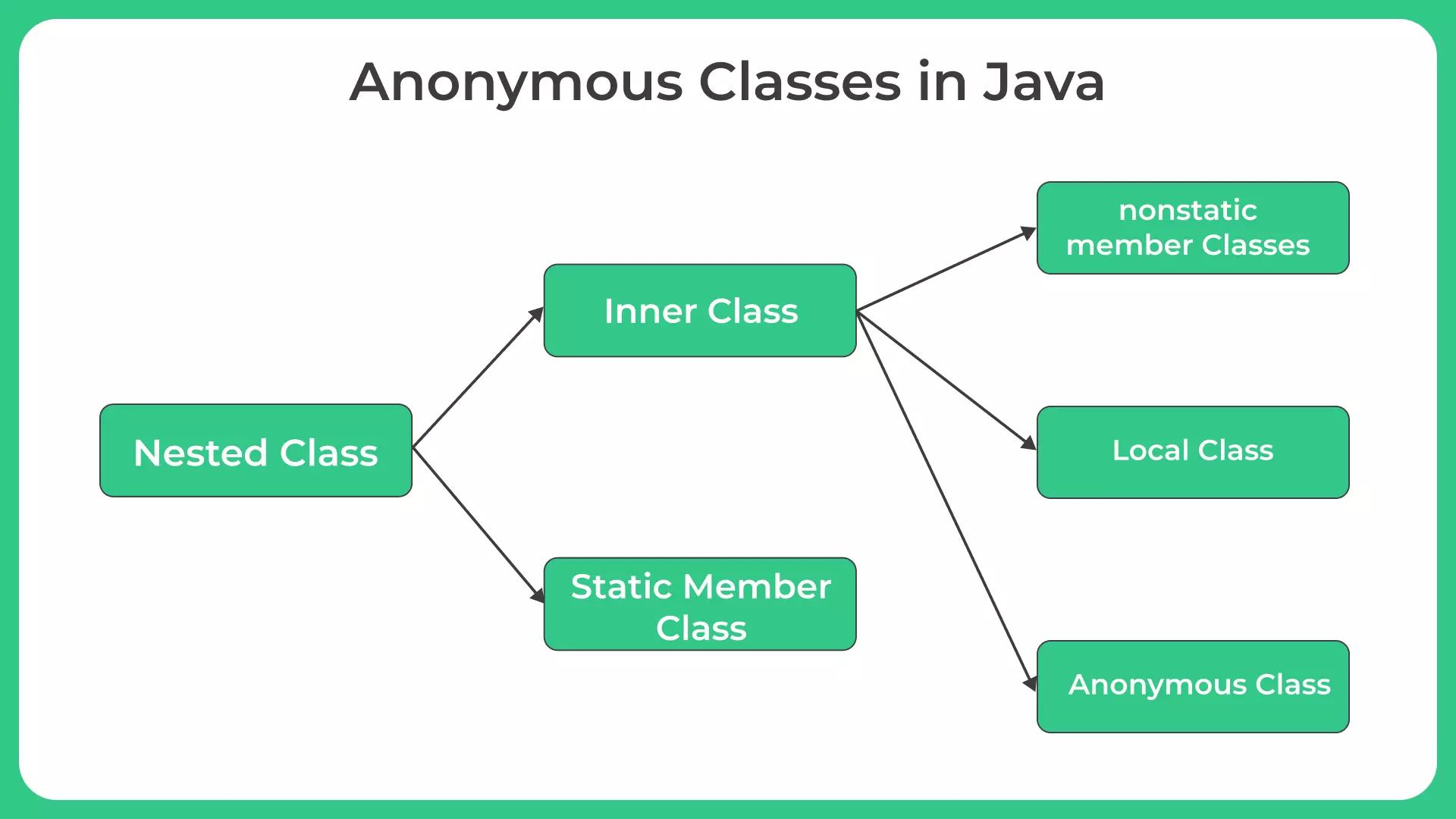0
Notifications Mark All Read
No New notification
- Login
- Get Prime
Anonymous Classes in Java

Introduction to Anonymous Classes in Java
Anonymous classes in Java, which provides a concise and localized approach for implementing interfaces and classes without the need for explicit declarations.
This article explores the intricacies of anonymous classes in Java, their syntax, benefits, examples of usage, limitations, best practices, and more.
What is an Anonymous Class in Java ?
An anonymous class in Java refers to a class that is declared and instantiated simultaneously without providing a name. It serves the purpose of implementing an interface or extending a class while being used within a limited scope.
Anonymous classes are often employed for one-time usage, particularly in scenarios where a small implementation is needed without the need to create a separate named class.
Syntax and Structure
The syntax for creating an anonymous class involves defining the class type it implements or extends, followed by curly braces that enclose the class body. Since anonymous classes do not have explicit names, they are instantiated immediately after the closing braces.
< InterfaceType > /< Superclass > referenceVariable = new < InterfaceType >/() { // Class body };

Anonymous Class in ActionListener
Anonymous classes find practical application in event handling, such as implementing ActionListener. Suppose we have a button that performs a specific action when clicked.
Instead of creating a separate class for the ActionListener implementation, we can use an anonymous class directly within the button’s event registration code. This approach saves time and keeps the code focused and localized.
button.addActionListener(new ActionListener() {
public void actionPerformed(ActionEvent e) {
// Perform the desired action
}
});
Anonymous Class for Runnable
Anonymous classes are also useful when working with threads and implementing the Runnable interface. Instead of creating a separate class for the thread’s logic, an anonymous class can be used to define the run() method directly.
Thread thread = new Thread(new Runnable() {
public void run() {
// Thread logic goes here
}
});
Limitations and Considerations
- Access to Local Variables
- Anonymous classes have access to local variables and parameters of the enclosing scope. However, these variables must be effectively final, meaning their values cannot be modified once assigned. This restriction ensures stability and prevents unexpected behavior.
- Inheritance and Interfaces
- Anonymous classes can extend a class or implement interfaces, but they cannot do both simultaneously. It is essential to choose the appropriate approach based on the requirements of the implementation.
Best Practices for Using Anonymous Classes
When utilizing anonymous classes in Java, it is important to follow certain best practices to ensure clean and efficient code. Consider the following recommendations:
- Avoid Complex Implementation
- While anonymous classes provide a concise way to implement interfaces or extend classes, it is best to keep the implementations simple and focused. Complex logic and extensive functionality are better suited for separate named classes. Anonymous classes are most effective when used for small, localized tasks that require minimal code.
- Use Lambda Expressions Instead
- With the introduction of lambda expressions in Java 8, it is often more preferable to use them instead of anonymous classes for implementing functional interfaces. Lambda expressions offer a more concise and expressive syntax, leading to cleaner code. They are especially useful when working with interfaces that define a single abstract method, such as functional interfaces.
Conclusion of Anonymous Classes in Java
In conclusion, anonymous classes in Java provide a convenient way to implement interfaces or extend classes without the need for explicit declarations. They offer benefits such as code conciseness, localized implementations, and simplified event handling.
When using anonymous classes, it is important to consider the limitations and considerations, such as access to local variables and choosing between inheritance and interfaces. Following best practices, such as avoiding complex implementations and utilizing lambda expressions where applicable, can lead to cleaner and more efficient code.
Prime Course Trailer
Related Banners
Get PrepInsta Prime & get Access to all 200+ courses offered by PrepInsta in One Subscription

Question 1. What is the difference between an anonymous class and a named class?
Anonymous classes and named classes differ in their declaration and usage. Anonymous classes are declared and instantiated at the same time without providing a separate name, while named classes are explicitly declared with a class name. Anonymous classes are often used for one-time implementations or in scenarios where a small, localized implementation is required without the need for a separate class declaration.

Question 2. Can anonymous classes have constructors?
Yes, anonymous classes can have constructors. However, these constructors are only used for initializing the anonymous class itself and cannot be invoked directly from outside the anonymous class. They are typically used to pass arguments to the superclass or to perform additional initialization within the anonymous class.

Question 3. Are anonymous classes used only in Java?
No, anonymous classes are not exclusive to Java. While the concept of anonymous classes originated in Java, other programming languages have similar constructs. For example, languages like C# and Kotlin also support anonymous classes or similar mechanisms for implementing interfaces or extending classes without explicitly naming them.
Get over 200+ course One Subscription
Courses like AI/ML, Cloud Computing, Ethical Hacking, C, C++, Java, Python, DSA (All Languages), Competitive Coding (All Languages), TCS, Infosys, Wipro, Amazon, DBMS, SQL and others

 0
0


Login/Signup to comment